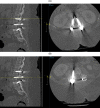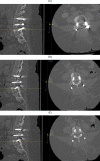Hemangioma of the Lumbar Spine Involving the Spinous Process: A Rare Case Report and Review of the Literature
- PMID: 33900946
- PMCID: PMC7888200
- DOI: 10.14444/7166
Hemangioma of the Lumbar Spine Involving the Spinous Process: A Rare Case Report and Review of the Literature
Abstract
Hemangiomas of the spine are usually benign and asymptomatic. They can cause devastating complications such as pathological fractures of the spine and neurological disability. This report documents an atypical location of a hemangioma in a lumbar spinous process, in combination with a spondylolisthesis at the same level, which makes it even more uncommon. Surgery can be effective and safe and can significantly improve patient outcomes. Moreover, prior embolization can prevent acute hemorrhage in addition to providing careful diagnosis and evaluation.
Keywords: embolization; hemangioma; spinous process hemangioma; spondylolisthesis; surgery; vertebral body hemangioma.
This manuscript is generously published free of charge by ISASS, the International Society for the Advancement of Spine Surgery. Copyright © 2020 ISASS.
Conflict of interest statement
Figures









References
-
- Malawski S, Sokólski B. A case of spinal hemangioma uncommonly located within spinous processes and laminae of Th12. Chir Narzadow Ruchu Ortop Pol. 1996;61(1):47–51. - PubMed
LinkOut - more resources
Full Text Sources
Other Literature Sources
